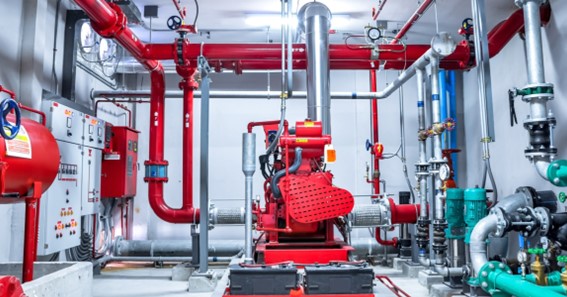Fire control systems in buildings are designed to keep building occupants safe and prevent fire damage. They can be passive or active and must work together to function properly.
The key requirements for fire protection are to detect fire in its incipient or growth stage, notify occupants using fire alarms and provide safe fire escape routes.
Smoke Detectors
Smoke detectors are a vital part of any fire control system in buildings, and they provide early warnings of fires in a building. They also help to alert occupants to smoke-related emergencies so they can move quickly outside or call for help.
There are different types of smoke detectors to choose from, depending on your needs. One type, called ionization smoke detectors, uses a small amount of radioactive material to ionize the air. Then, the smoke disrupts the flow of electricity between the two oppositely charged plates, triggering an alarm.
The National Fire Protection Association (NFPA) recommends installing a minimum of one smoke alarm on each level of your home, including the basement. It’s also a good idea to have one detector outside each bedroom.
You can choose to have your detectors hardwired or battery-operated. Both work, but hardwired models are more reliable, and they also come with a backup battery to ensure that they continue to function in the event of power outages.
Whether you opt for battery-operated or hardwired smoke detectors, regularly check them for proper operation and maintenance. It includes pressing the test button monthly, vacuuming them annually or sooner if necessary, and replacing batteries yearly unless they have a long-life non-replaceable battery.
Click here – Methods to Recover Lost Data from External Hard Drive [Quick Methods]
Fire Sprinklers
A fire sprinkler system aims to extinguish a fire before it causes damage and loss of life, using water to stop the spread of the flames quickly. There are several different kinds of sprinkler systems, each suited to a specific kind of building.
A sprinkler head is a sprinkler system component that discharges water onto a fire when activated. They are available in assorted designs, with various spray patterns and sizes to suit your building.
Sprinkler heads are typically made from a glass bulb or a two-part fusible link held together by a fusible alloy, which expands when heated by hot gasses generated from a fire. This pressure causes the bulb to break, and the link releases a burst of water directly onto the fire.
These systems are incredibly effective at putting out fires, with fire sprinklers operating 91 percent of the time when activated in buildings and reducing deaths and property loss by 65 percent. It means they’re a valuable and critical piece of fire protection that every business owner should consider.
When installing a sprinkler system, you must consider the type of building you’re protecting, the code requirements for your area, and the types of items that may be stored in your facility.
Fire Extinguishers
When a fire breaks out in your office, you must know how to use the correct extinguisher. Most extinguishers work by removing one of the four elements needed to start a fire: fuel, heat, oxygen, and a barrier to prevent the fuel from re-igniting.
You should also have trained responders in your business who can help you with evacuation procedures and emergency plans. It includes training employees in properly using fire extinguishers and other safety measures.
Most commercial and industrial buildings will have automatic fire suppression systems installed. These systems will detect smoke or heat and automatically activate the system, which can then spray water at the source of the fire to put it out.
These systems can effectively suppress fires early before they become too big and dangerous to put out on your own. They can also be an essential feature in your building because they can reduce property damage and minimize recovery time after a fire.
Fire extinguishers can be handheld or cart-mounted and come in different styles, shapes, and sizes. They are generally divided into five classes: CLASS A, CLASS B, CLASS C, CLASS D, and CLASS E.
Click here – The 5 Steps That Nurses Take to Create a Care Plan for a Patient
Fire Alarm
Fire alarms can save lives, reduce property loss and shorten recovery time. They also communicate clearly between firefighters and building occupants, who may be separated by smoke or thick walls.
These systems can be installed in homes, businesses, hotels, and other buildings where people live, work, and travel. Local and national fire safety laws highly regulate them.
They can also be used to alert the occupants of the building in case of emergencies such as active shooters, carbon monoxide poisoning, leaky pipes, and severe weather. They can be located in the main building area or separately.
Some fire alarms also have a hush feature that allows for temporary silence if the system gets too noisy or if the battery is removed.
While these systems can be expensive, they are essential to every fire protection plan. NFPA statistics show that in the U.S., more than half of all home fire deaths occur in houses with no working smoke alarms or in homes with not enough working smoke alarms.
NFPA recommends that all occupied areas of buildings have at least one smoke and heat detector and two or more fire extinguishers. They also recommend installing a fire sprinkler system and a fire exit sign in each building area. These systems should be connected and the local fire department. They should be monitored and maintained by a certified professional.

